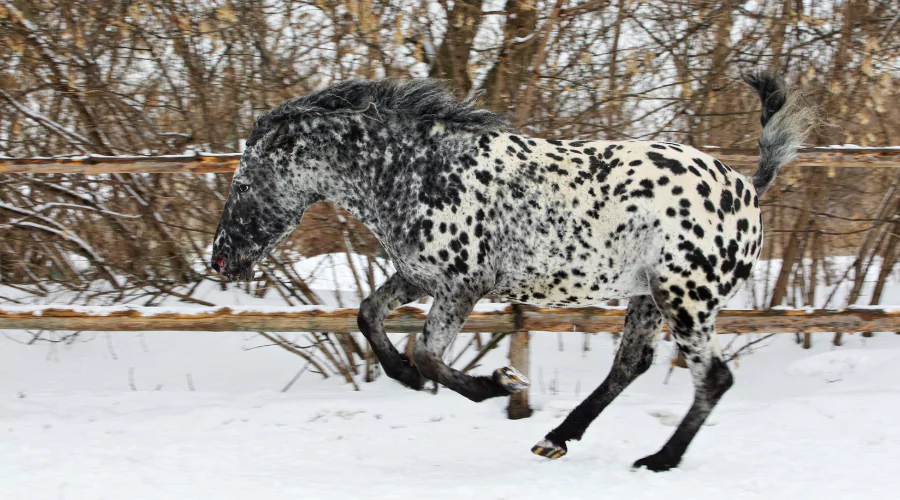The animal realm is full of wonders that attract the human mind, and horses stand out for their grace and beauty. The spotted horse breeds are particularly interesting, since they have not only captivated equestrian fans but have also played important roles in history and culture across the world. These speckled beauties, which range from the white and brown spotted horse to the all-white spotted horse, exemplify the variety of nature’s artwork. In this post, we will look at the rich tapestry of history and the origins of these incredible animals. In addition, we’ll discuss different sorts of spotted horse breeds, providing light on their distinct qualities and long-lasting attractiveness.
Origin and History of Spotted Horse Breeds
The story of spotted horse breeds is both old and interesting. Horses with spots may be seen in cave paintings and artifacts going back thousands of years, demonstrating that these animals have coexisted with humans throughout history and throughout civilizations. The demand for horses with speckles or unusual coat patterns is more than just a current aesthetic choice; it has profound historical origins. Some scientists believe the spotted horses originated in Asia, while others think they first appeared in Europe. In any case, these unusual marks spread rapidly over the globe via commerce and conquering, with each location establishing its own breeds.
The Beauty and Genetics Behind Spots
To comprehend the attractiveness of spotted horse breeds, one must first recognize the complicated genetics at work. Speckled horses breeds, like the well-known white spotted horse, get their distinctive patterns from a combination of genetic characteristics that control pigmentation distribution and intensity. This section will look at how these genetic variables lead to the astonishing diversity seen in these horses. It will also discuss how selective breeding and natural selection influenced the physical traits of these breeds.
The diversity and brightness of patterns seen in spotted horse breeds are the result of a remarkable genetic interaction. Each horse’s distinct coat pattern is the result of precise genetic combinations that influence pigmentation distribution, resulting in a variety of patterns ranging from leopard spots to blanket and snowflake. The Leopard Complex (LP) gene is responsible for these different patterns, and when present, it may generate a variety of spotted patterns based on other genetic variables and modifier genes. Beyond their visual appeal, these genetic variants have practical significance, impacting everything from natural camouflage to the cultural and economic worth of horses in human communities.
Selective breeding has been useful in improving and keeping these desirable characteristics. Humans have deliberately bred horses over millennia to magnify or retain various coat patterns, resulting in the diverse varieties we know today. Meanwhile, natural selection has played a role; in particular situations, specific coat patterns may provide survival benefits, affecting the prevalence of these features in wild populations. This dynamic interaction of genetics, human preferences, and natural environmental constraints has molded the development and distribution of the gorgeous spotted horse breeds we see today.
The Role of Spotted Horses in Culture and Society
Beyond their genetic makeup, spotted horses have played important roles in many civilizations and communities. Horses with spots are loved in mythology and folklore for reasons other than their physical appearance. They are also viewed as emblems of rank and riches.
Spotted horses have long been praised for their distinctive markings, but they have also become a part of the fabric of many civilizations and communities throughout the world. They’ve often been seen as emblems of riches, power, and distinction, demonstrating their significance beyond basic aesthetics. Horses with distinctive coat patterns, for example, were often recognized as spirit animals in Native American civilizations, thought to carry strong medicine and provide their riders with protection and distinction. Similarly, in European traditions, knights and aristocracy often wanted horses with distinguishing marks, thinking they reflected their owners’ heroism and position.
Their impact extends to mythology and folklore, where these horses are often represented as legendary entities or as the chosen mounts of gods and heroes, indicating their treasured place in the human imagination. The dappled steeds of Apollo, who pulled the sun across the sky in Greek mythology, or Sleipnir, Odin’s eight-legged horse in Norse tale, are good instances of how spotted horses have represented extraordinary power and divine favor.
This cultural importance has affected commerce, military, and diplomatic ties, since the exchange of magnificent horses sometimes represented alliances or functioned as important presents between countries and leaders. Spotted horses were coveted assets in both historical and modern settings due to their desired traits, which included power, speed, and stamina in addition to beauty. Their significance in society and culture goes much beyond mere function or decoration, ingraining them profoundly into human history and tradition.
Notable Spotted Horse Breeds
In this part, we will introduce and briefly explore horse breeds that represent the incredible range of spotted horse breeds. Each breed, from the Appaloosa with its leopard-like markings to the Knabstrupper with its striking coat, offers a tale about evolution, breeding, and human preferences that have shaped their existence.
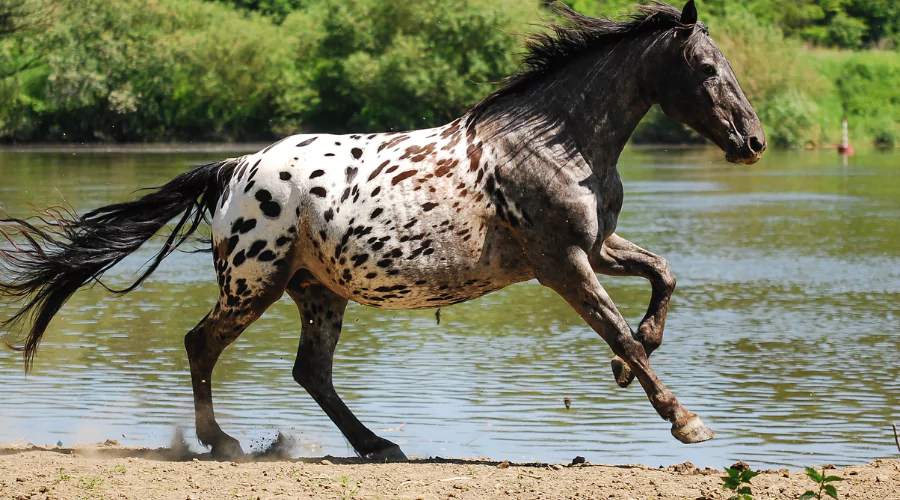
Appaloosa
The Appaloosa horse breed, known for its lovely, spotted coat, is one of the most recognized in the world, with a history as colorful as its distinguishing markings. The breed originated in the Pacific Northwest of the United States and was initially established by the Nez Perce Native American tribe, who were accomplished riders and breeders. The Appaloosa’s coat patterns vary from leopard spots to blankets and roan variations, each as distinct as a fingerprint.
The Nez Perce deliberately chose and developed these horses to have stamina, strength, and agility, all of which were necessary for hunting, combat, and transportation purposes. The name “Appaloosa” is derived from the Palouse River, which flows through the heart of Nez Perce territory, emphasizing the breed’s strong geographic and cultural links to its roots.
Aside from their distinctive look, Appaloosas are noted for their adaptability, having been employed in a wide range of equestrian disciplines including as racing, show jumping, and trail riding. Their pleasant demeanor and intelligence make them suited for riders of all abilities.
Unfortunately, the nineteenth-century Nez Perce War with the United States government resulted in the near extinction of the original Appaloosa. Only through the united efforts of horse lovers in the twentieth century was the breed restored, and it has since had a revival in popularity. Today, the Appaloosa is more than just a symbol of American heritage; it is also a living connection to the Nez Perce tribe’s rich history and horse breeding traditions. The Appaloosa Horse Club, founded in 1938, works to conserve and promote the breed’s lineage, ensuring that these majestic horses reflect the Nez Perce’s cultural heritage and horse breeding expertise.
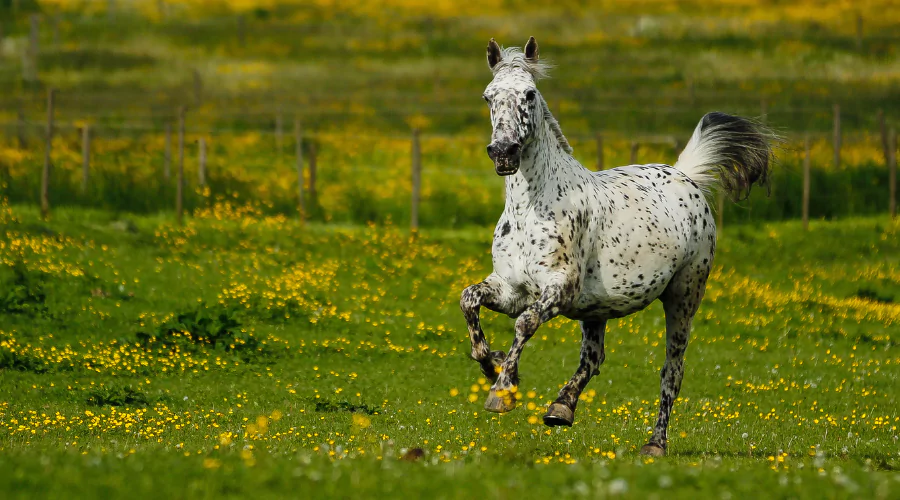
Knabstrupper
The Knabstrupper breed, whose roots may be traced back to early nineteenth-century Denmark, is distinguished by its unusual coat, which has enormous, dramatic blotches that can cover the whole body. This striking pattern is the consequence of a complicated genetic characteristic, similar to one seen in the Appaloosa, that controls skin color. The breed’s history may be traced back to a founding mare acquired by Major Villars Lunn, the owner of Knabstrup Manor, from whence the breed derives its name. Flaebe, a mare, was coupled with numerous stallions, resulting in progeny with characteristic spotted coats and creating the framework for the Knabstrupper breed.
Knabstruppers are admired not just for their distinctive look, but also for their adaptability and skill in a wide range of equestrian sports. They excel in dressage and show jumping, where their agility, intelligence, and eagerness to learn make them formidable competitors. Beyond competitive arenas, Knabstruppers are utilized for general riding, therapy horses, and even circus acts, demonstrating their versatility and adaptability.
Physically, the Knabstrupper reaches 15.2 to 16 hands tall, with a powerful shape that blends strength and grace. Their coats may have a variety of patterns, including leopard spots, fewer, bigger spots, and even pure colors. Despite their differences in appearance, all have the breed’s distinguishing features of a strong, arched neck, muscular hindquarters, and a straight profile.
The breed was on the verge of extinction in the mid-twentieth century, owing mostly to the introduction of motor vehicles, which reduced the need for work horses, and the devastation of World War II, which reduced breeding stock numbers. Efforts by Danish breeders in the later part of the twentieth century, however, managed to restore the Knabstrupper, which is now popular across Europe and beyond. The Knabstrupper is not only appreciated for its beauty and athletic skill, but it also represents cultural history and equestrian variety. The Knabstrupper foreigner for Denmark (Knabstrupper Association for Denmark) continues to monitor breeding and registration, preserving the breed’s survival and tradition.
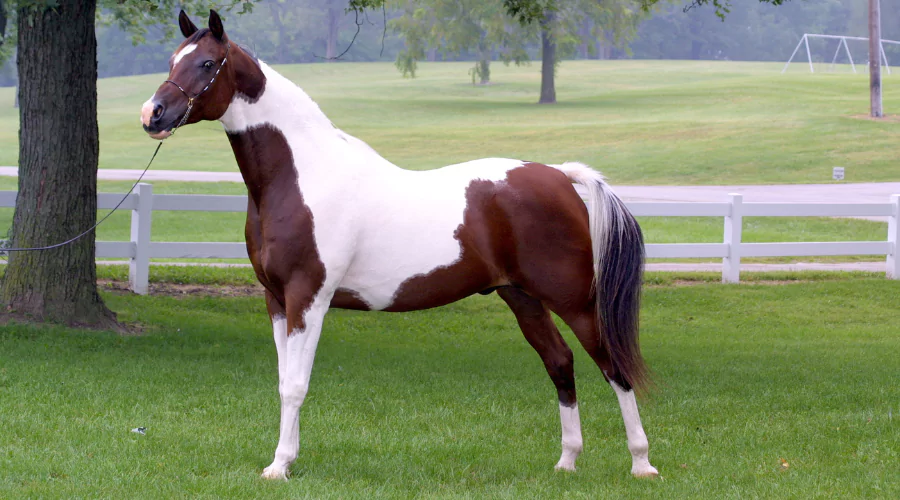
Pinto
The Pinto horse is identified not by its breed, but by its distinctive coat colors, which has big patches of white and another color, usually black or brown. This remarkable pattern is divided into two categories: tobiano, in which white patches cross the back and continue down over the legs, and overo, in which the color extends from the horse’s bottom, leaving the back black. There is also a third, less popular form known as tovero, which combines tobiano and overo patterns.
Pintos come in a variety of breeds, and their unusual coloring has been treasured for millennia by civilizations ranging from Native American tribes to European nobles. Pintos are as versatile as their breeds, competing in disciplines like as western pleasure, English disciplines, driving, and even therapeutic riding because to their generally calm and pleasant demeanor.
Historically, Native American tribes used the pinto design for ceremonial reasons as well as battle paint, believing that the different patterns might fend off bad spirits. Today, groups such as the Pinto Horse Association of America aim to conserve pinto patterns in horses by documenting their ancestry and advocating breeding procedures that ensure the health and vitality of these visually appealing animals. Pintos continue to captivate the imagination of horse fans all around the globe, revered not just for their beauty but also for their energy and flexibility.

Paint
Paint horses, as distinguished members of the equine community who are recognized with the American Paint Horse Association (APHA), enchant spectators with their sparkling coat patterns. These patterns combine white with another color—typically black, brown, or bay—to produce a stunning visual contrast that emphasizes each horse’s distinct personality. Paint horses are a cross of Spanish Barb, Andalusian, and Arabian lineages, and they contribute not just beauty but also a rich cultural legacy. They are known for their amiable, calm, and intelligent demeanor, and they make wonderful partners for riders of all skill levels, excelling at anything from ranch labor to competitive exhibiting.
The American Paint Horse Association, formed in 1962, is vital to the promotion and protection of the Paint horse via thorough registration systems that preserve the breed’s purity and health. A particular coat pattern, as well as certain lineage standards, are important registration criteria. The association divides these patterns into two categories: Tobiano, which is distinguished by large, rounded spots over a dark or colored base coat that frequently crosses the back, and Overo, which is distinguished by sharp, irregular white patches that do not usually cross the back, giving the appearance of a color frame over a white background.
Aside from their looks, Paint horses are known for their flexibility, demonstrating exceptional skill in disciplines like as western riding, dressage, show jumping, and trail riding. Their versatility and eagerness make them excellent prospects for not only professional sports, but also leisure riding and rehabilitative programs. The APHA contributes considerably to the Paint horse’s long-term appeal and legacy by cultivating a worldwide network of fans and breeders, establishing them as icons of beauty, resilience, and variety in the equine world.
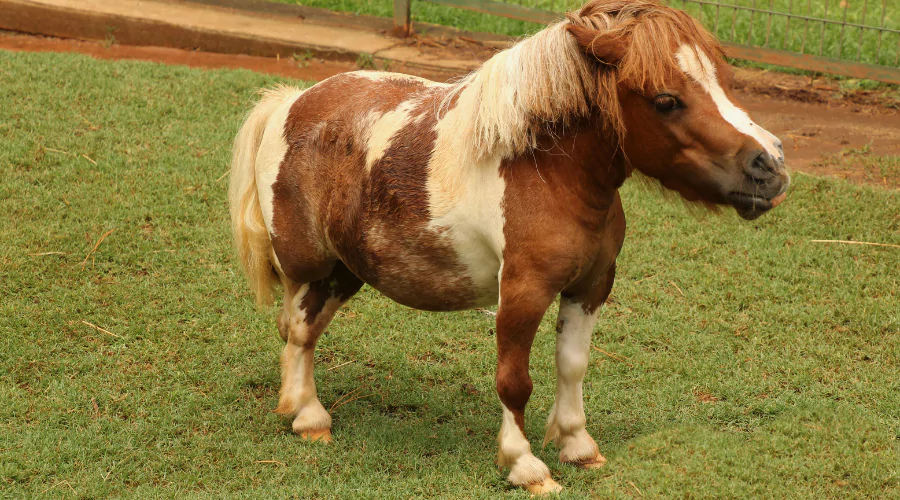
Miniature Horse
The Miniature Horse is a little, charming horse breed that charms people with its modest stature and amiable demeanor. Miniature Horses, known for standing no higher than 38 inches at the withers, encapsulate the grace and proportions of a full-sized horse on a much smaller scale. Those with spotted patterns, such as pintos or appaloosas, have a unique fascination owing to their stunning look and are often highly valued.
Miniature Horses are more than just ornaments; they are adaptable, clever, and capable of engaging in a number of activities. They thrive in age-appropriate competitive sports such as jumping, driving, and obstacle courses. Aside from competition, they make excellent therapy animals, visiting hospitals and nursing homes where their soft demeanor may have a profoundly calming effect on patients.
With roots dating back to the 1600s in Europe, when they were reared as pets for aristocracy, today’s Miniature Horse blends the refinement of years of careful breeding. Aside from their visual attractiveness, they are recognized for their strength and longevity, typically surviving well into their thirties.
The American Miniature Horse Association (AMHA) and the American Miniature Horse Registry (AMHR) are two major organizations that promote and register Miniature Horses in the United States. These organizations set the bar for breed quality and conduct events to promote the Miniature Horse’s talents and attractiveness.
Miniature horses, especially those with spotted patterns, are becoming more popular, with enthusiasts and breeders praising their beauty, flexibility, and the pleasure they offer to communities throughout the globe.
Care and Management of Spotted Horses
Caring for a spotted horse entails recognizing their specific requirements, from grooming to preserve their skin to controlling their food to keep their coats healthy and bright. This section will provide insights into the finest techniques for maintaining these magnificent creatures so that they have happy and healthy lives.
Proper grooming is essential for the health and beauty of spotted horses. Their coats’ distinct patterns and colors need frequent brushing to maintain them clean and lustrous, prevent matting, and avoid skin concerns caused by sensitive regions beneath spots or inside white patches. Bathing should be done with caution, using shampoos that are specifically developed to enhance and preserve their colorful coats from fading under the sun’s harsh rays.
Nutrition is just as crucial. A balanced diet suited to their unique requirements, taking into account their activity level and any health issues, may significantly improve the shine and vibrancy of their coat. Supplements meant to improve coat condition may be useful, but they should be selected with veterinarian approval to prevent oversupplementation.
To maintain these magnificent horses in peak condition, they must get regular veterinarian treatment such as vaccines, deworming, and dental exams. Because certain spotted horses are more vulnerable to certain skin problems or sunburn, particularly in weakly pigmented regions, UV protection in the form of sunscreen or protective gear may be required during peak sun exposure hours.
Finally, giving a secure and pleasant habitat with enough of room to wander and graze, shelter from extreme weather, and frequent social contact promotes their physical and mental well-being. Tailoring these factors to the specific qualities of spotted horses ensures that they have satisfying lives both in and out of the show ring.
Spotted Horses in Modern Equestrian Sports
Today, horses with spots are not only praised for their beauty, but also compete in a variety of equestrian sports. These breeds’ quickness, intelligence, and adaptability have enabled them to thrive in a variety of disciplines, including show jumping and endurance riding.
Spotted horses, notably Appaloosa and Paint breeds, have made great advances in show jumping. Their distinctive coloring, along with athleticism and intelligence, distinguishes them in the competitive field. Riders respect these horses not just for their remarkable look, but also for their agility and accuracy, which are essential for traversing the difficult courses meant to test their physical and mental ability.
Endurance riding is another area in which spotted breeds thrive. The hardiness inherent in breeds like the Knabstrupper, with its characteristic leopard complex marking, enables these horses to perform very well over long distances. These horses exhibit not just stamina and durability, but also steadiness and the capacity to form a close relationship with their riders, which may be critical to success in endurance contests.
Spotted horses’ success in this and other equestrian sports is based on their adaptability, which breeders and trainers have developed over centuries. This adaptability has enabled spotted horses to transcend prejudices and emerge as effective competitors in a wide variety of equestrian disciplines, demonstrating that beauty and performance are compatible.
Conservation and the Future of Spotted Horse Breeds
Finally, we will look at the efforts being undertaken to preserve and safeguard the genetic variety of spotted horse breeds. With certain breeds facing extinction, conservation efforts are critical to ensure that future generations may enjoy and benefit from these beautiful creatures.
To summarize, the world of spotted horse breeds provides an intriguing peek into the beauty and complexity of equine genetics, history, and human culture. Whether it’s the speckled horse breeds of a white and brown spotted horse or the remarkable look of a white spotted horse, these creatures continue to capture and delight people all over the world.
Frequently Asked Questions (FAQs)
What are the most common health concerns for spotted horses?
Spotted horses, like other horse breeds, might be susceptible to certain health problems. Skin disorders, notably sunburn and photosensitivity, are widespread owing to pigmentation patterns. It is critical to give children with UV protection and do frequent skin examinations to detect any concerns early.
Can any horse breed have a spotted coat?
Spotted coats are most usually associated with certain breeds like as the Appaloosa, Knabstrupper, and Paint Horse, however genetic abnormalities that cause spots may occur in practically any breed. However, the frequency and pattern of spotting will vary greatly.
How can I tell if my spotted horse is a purebred?
To check whether a spotted horse is purebred, contact breed organizations such as the American Miniature Horse Association (AMHA) or the American Miniature Horse Registry (AMHR) for Miniature Horses, or comparable registers for other breeds. They can give data via pedigree analysis and, in certain situations, genetic testing.
Are spotted horses more expensive than non-spotted horses?
A horse’s price may be impacted by a variety of characteristics, including breed, ancestry, training, and coat pattern. Spotted horses may be more expensive, especially if they have a very desirable pattern or hue. However, the total cost will be determined by a variety of circumstances.
What is the best way to protect a spotted horse’s coat from fading?
To prevent fading of a spotted horse’s coat, appropriate maintenance, diet, and sun protection are required. Using UV-blocking fly sheets or sunscreen on exposed areas, as well as eating an omega-rich diet and taking coat-enhancing vitamins as prescribed by a veterinarian, may help retain coat color.
You May Also Like:
8 Beautiful White Horse Breeds
German Horse Breeds: A Quest for Elegance and Power
5 Small Horse Breeds: Little Horses, Big Charm
A Guide to Racing Horse Breeds
8 Powerful Draft Horse Breeds: Titans of Labor
